Mexico City is the biggest city in North America. With a burgeoning culinary and art scene, there are plenty of things to keep you occupied for a few days. It also has the most museums in the world. While the recent earthquake did some major damage to the city, the touristy areas are still intact and they need visitors now more than ever. To help you plan a great trip to the massive metropolis known as DF, here are 12 kickass things to do in Mexico City.
Is It Safe to Travel in Mexico City?

The subway has a car for women and children only.Since our trip, many people have asked us if we felt safe in Mexico City.
The answer is a resounding “Yes!” Mexico City has undergone a lot of changes and really cleaned up in the last few years. They’ve managed to distance themselves from the drug wars.
These days, a large population of foreigners resides there and more are moving there every month. We spent a full week in the city and the worst thing that happened was when a guy grabbed my butt on the subway during rush hour. I started riding in the women’s and children’s car after that.
We weren’t pick-pocketed, nobody tried to mug us, and we never felt like we were in danger.
Things to do in Mexico City
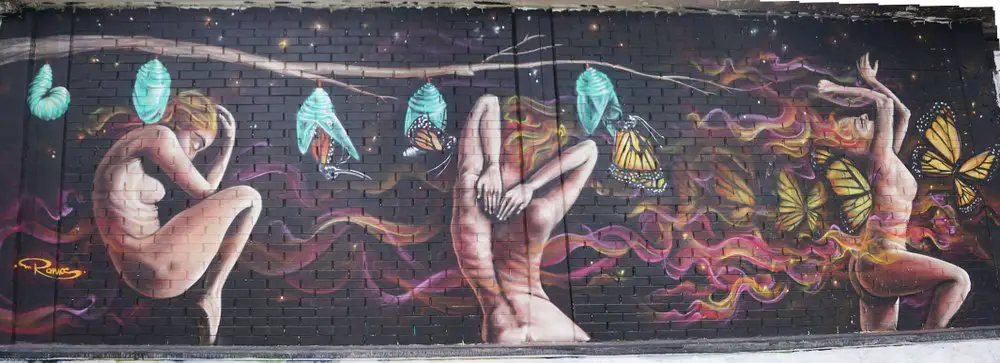
Visit Templo Mayor
The Templo Mayor is the main temple of the former Aztec capital city Tenochtitlan, which is now Mexico City. The temple is thought to be in the exact spot where the Aztecs first saw the now symbol of the city – an eagle sitting on a cactus with a snake in its mouth.
Back when the Spaniards took over, the temple was taken apart and covered over by the new colonial city.
Excavators found several small parts of the temple in the early 20th century. However, it wasn’t until 1978 that the area was fully excavated after employees of the electric company found a massive, pre-Hispanic stone disc with an Aztec goddess carved on it.

There’s a museum on site with artifacts found in the excavation that’s full of historical information and models of the former capital.
It’s part of the Historic Center of Mexico City and was named a UNESCO World Heritage Site in 1987.
Open Tuesday – Sunday 9 am – 5 pm, $70 MXN/person.
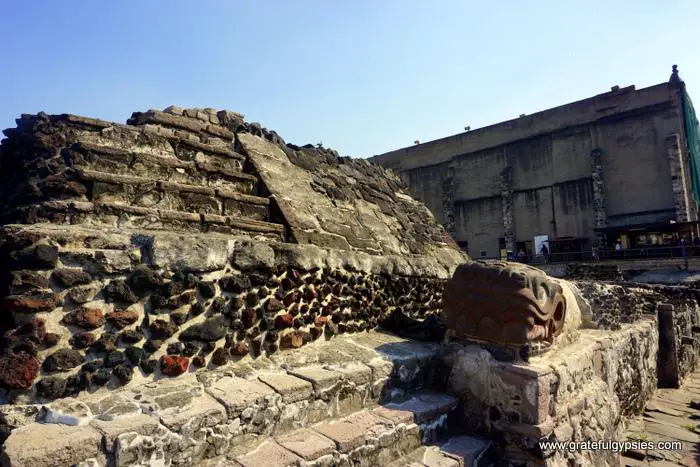
Check Out the Palacio Nacional
The Palacio Nacional (National Palace) is where you’ll find the offices of the President of Mexico as well as the Federal Treasury.
It’s located in the Zocalo (historic center) and has a long history in the city. The site has been the palace for the ruling class of Mexico dating all the way back to Moctezuma II – the ninth ruler of Tenochtitlan during the Aztec Empire. A large portion of the current palace’s building materials is from the original structure.

There are some epic Diego Rivera murals on the walls of the Palace depicting Mexican civilization of indigenous life before the Spanish conquest.
Unfortunately for us, we didn’t see the murals.
The first time we visited the Palace, we simply couldn’t find the proper entrance (there are several) and went in the Museum of Cultures instead. It wasn’t that upsetting as they had a special exhibit about ethnic minorities in China. It gave us a nice feeling of nostalgia for our travels there.
The second time we tried, there was an event going on and tourists were not allowed inside. We’ll just have to try for a third time. Third time’s the charm!
Open from Tuesday – Sunday 9 am – 5 pm, free.
Check out part 1 of Sasha’s video tour around Centro Historico:
Admire Murals in the Palacio de Bellas Artes
If you fail to see the murals in the National Palace (like us), never fear!
There are some pretty epic murals in the Palacio de Bellas Artes (Palace of Fine Arts). This neoclassical and art nouveau building is a prominent cultural center and is one of the most popular things to do in Mexico City. The theater inside is an art masterpiece in and of itself. However, it’s only possible to go in if you’re seeing a performance.
Sadly, there were no performances that fit into our schedule on our visit. Check their Twitter page to see if there’s a performance you can attend.

The second and third floors are where you’ll find the murals.
There are murals from Diego Rivera, David Alfaro Siqueiros, and Jose Clemente Orozco. “Man At the Crossroads” is the mural that the Rockefellers had commissioned from Rivera for New York City’s Rockefeller Center. The Rockefellers destroyed the original because of its anti-capitalist themes, but Rivera recreated it here in 1934.
Pull up the Wikipedia article and spend some time trying to find the various scenes in the painting. The fourth floor is the Museum of National Architecture and has changing exhibits.
Open Tuesday – Sunday 10 am – 6 pm. Entry is $62 MXN/person, $30 pesos for a photo pass.

Sunset Drinks at Torre Latinoamericana
Just around the corner from the Palacio de Bellas Artes is Torre Latinoamericana, a massive skyscraper.
At the time of its construction, it was the tallest building in Latin America. It has withstood several earthquakes, including the most recent one last month (September 2017), thanks to pylons that anchor the building.

You can buy a ticket to go up to the observation deck on the 44th floor, or for about the same price you can order a few drinks at the bar on the 41st floor.
It’s a great place to get an aerial view and see just how sprawling the city is. Just before sunset is the best time to go as you can watch the city light up.
Open daily 9 am – 10 pm, $100 pesos/adult, $70/child to go to the observation deck or free if you’re just going to the bar.

Listen to Mariachi Bands in Plaza Garibaldi
Plaza Garibaldi really gets a bad rap on the internet. We almost didn’t go because of all the negative reviews but we’re really glad we did.
There were some bums and weirdos hanging around but it was no worse than what you would find in New York City or Chicago.

The Museo de Tequila y Mezcal (Museum of Tequila and Mezcal) at the front of the square is worth a visit. It has exhibits on the production of, you guessed it, tequila and mezcal – Mexico’s two distilled agave drinks.
The ticket also includes a tasting at the roof-top bar overlooking the plaza.
There are plenty of little restaurants around the plaza offering cheap, delicious food. Pull up a chair, grab a cerveza, and hire a Mariachi band for a ballad or three.
The best time to visit is in the evening. Entrance to the Museo de Tequila y Mezcal is $60 pesos/person. We paid a Mariachi band $110 pesos for three songs.
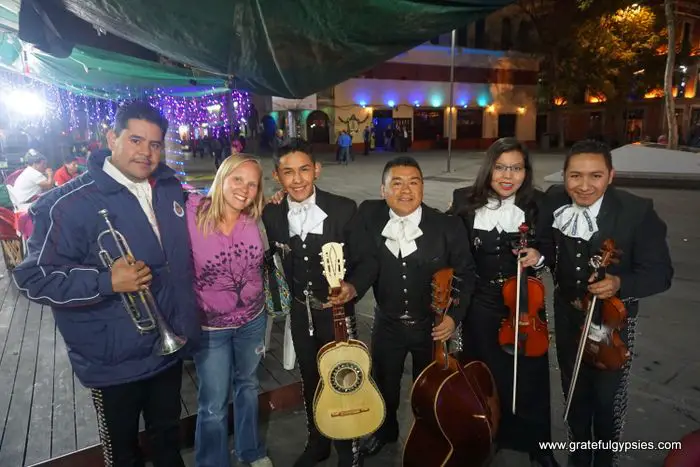
Check out part 2 of Sasha’s video tour around Centro Historico:
Spend an Afternoon in Bosque de Chapultepec
One of our favorite things to do in Mexico City – hang out at the park and tour the Chapultepec Castle.
At just under 1,700 acres, Bosque de Chapultepec is one of the largest city parks in the western hemisphere. One of the park’s main tasks is to function as an ecological space in greater Mexico City.
It’s considered one of Mexico City’s “lungs” because the trees replenish oxygen to the Mexico Valley. In the past, it served as a retreat for Aztec rulers.

Chapultepec Castle was built in the colonial period and served as the official residence of the Mexican head of state until 1940.
It is the only royal castle in mainland North America. The Mexican Emperor Maximillian I lived there during the second Mexican Empire.
Now it houses the National Museum of History.
The name “Chapultepec” comes from the Nahuatl word chapoltepēc which means “at the grasshopper’s hill.” Sitting at 7,628 feet above sea level, the castle offers incredible views of the city and surrounding forest.

The castle is really cool because it’s huge and many of the rooms are still set up with the same furniture as they were when it served as a residence.
It’s quite easy to spend many hours there wandering through the rooms and the garden on the roof.
Fun fact: the Castle was used in the Leonardo Dicaprio film Romeo + Juliet.
Open Tuesday – Sunday 9 am – 5 pm, $70 pesos/person.

Check out our video tour of Chapultepec Castle:
Visit the National Museum of Anthropology
Going to the National Museum of Anthropology definitely tops the list of things to do in Mexico City. In fact, it’s the #1 thing to do on Trip Advisor. It’s the biggest and most visited museum in the whole country.
Visitors can easily spend the entire day checking out the endless exhibits.

The bottom salas (halls) are all dedicated to pre-Hispanic Mexico and the upper floors show how descendants of Mexico’s indigenous groups live today.
The exhibits depicting more recent history are located directly above their ancient counterparts so a good strategy for visiting is to see the ancient exhibit on the lower floor then head directly upstairs to learn about their modern-day lives.
Open Tuesday – Sunday from 9 am – 7 pm, $70 pesos/person.

See Lucha Libre
There’s nothing like seeing a Lucha Libre show at Arena Mexico. This is one of Mexico’s most popular sports to watch, falling just behind soccer or football as the rest of the world calls it.
The sport started in 1863 but didn’t gain popularity until the early 1900’s when two Italian businessmen began promoting no-holds-barred fights. In 1933 “the father of Lucha Libre,” Salvador Lutteroth Gonzalez, established the Empresa Mexicana de Lucha Libre (EMLL, The Mexican Wrestling Organisation) and the rest is history.

Going to a Lucha Libre show is quite similar to WWE Wrestling in the USA. Expect to see high-flying jumps, drama, and dialogue. It’s more of a show than a fight.
Check out our post all about Lucha Libre to learn everything you need to know about seeing the Luchadores in Mexico City.
Fights are held at Arena Mexico on Tuesday and Friday nights. You can buy tickets at the door or from Ticketmaster.
Join a Street Art Tour
Mexico City is full of colorful murals and graffiti art. The entire city is like a massive canvas. Street art, in general, is a phenomenon that has taken over the whole country.
Behind the colorful murals is a lot of history and culture that can be difficult to understand from an observer’s perspective.
You could try wandering the city and looking for the murals by yourself or you could join a street art tour. Joining a street art tour is the best way to learn about not only the paintings but the history and etiquette of street art and artists.

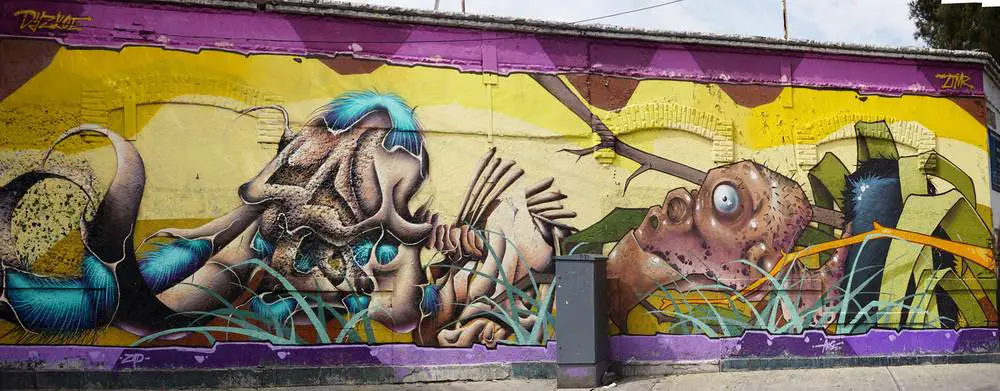
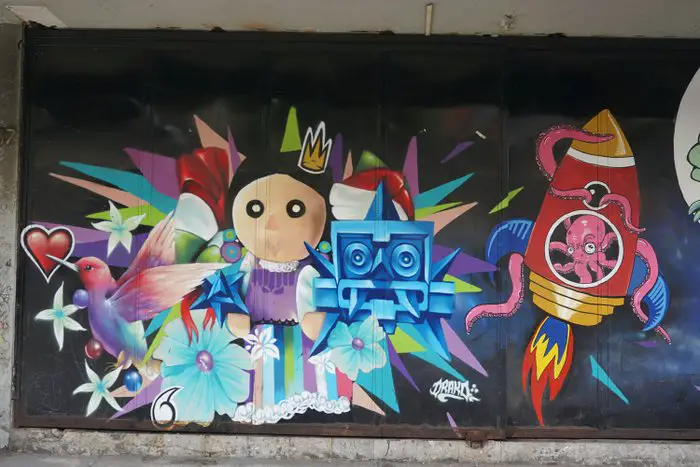
There are a few companies that do private street art tours of the historic center and other neighborhoods:
All of these companies have pretty great Trip Advisor ratings so simply choose the one that best fits what you’re looking for. Stylewalk offers completely private tours for street art as well as many other options.


Street Art Chilango is solely focused on street art and they have both group and private tours.
In addition to providing tours, they also secure mural commissions for artists. On their website, you’ll also find an interactive map of mural locations throughout the city. If you come across a mural that isn’t on the map, simply post it to Instagram with #streetartchilango and they’ll add it to their list.

Make the Pilgrimage to Basilica of Our Lady of Guadalupe
This is one of the most visited Catholic pilgrimage sites in the entire world, second in importance to the Vatican.
In December 2009 the Basilica of Our Lady of Guadalupe set the new world record with 6.1 million visitors over the anniversary of Our Lady of Guadalupe. It’s a large complex that has a Roman Catholic church, Basilica, and a shrine.

The story goes that an aspect of the Virgin Mary (Our Lady of Guadalupe) appeared to Juan Diego, an Aztec convert to Roman Catholicism, while he was walking between his village and Mexico City. She spoke to him in his native tongue and told him to build a church there.
He spoke to the Spanish bishop and told him what he had seen. The bishop didn’t believe him and ordered him to prove it with a miraculous sign.
The Virgin appeared again to Diego and told him to gather flowers, but it was winter time. Suddenly, Spanish roses appeared at his feet. When he presented them to the bishop, the flowers fell from his apron, revealing an imprinted icon of the Virgin.
The bishop ordered the church built at once.
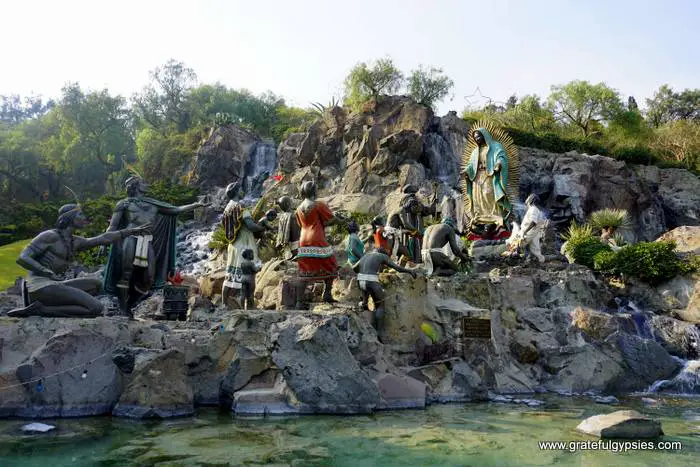
The original basilica that was built in 1536 still stands but it started to sink and the congregation outgrew the structure. They built a new one in the 1970s for the daily masses, but you can still enter the original.
Making this pilgrimage is extremely popular in Mexico. Pilgrims crawl on their knees for miles as they get closer to the church. Many believe that the Virgin of Guadalupe can cure almost any illness. That’s just how important she is in Mexican culture.
Check out our video tour of Basilica of Our Lady of Guadalupe:
Take a Day Trip to Teotihuacan
Located about 40 kilometers north of Mexico City, the sprawling archeological site of Teotihuacan was once a city of 150,000 people. In fact, it was the largest city in the Pre-Columbian Americas.
The name is Nahuatl for “the place where men became Gods,” and legend has it this is where the Gods gathered to plan the creation of man. Its cultural and artistic influence extended throughout the region as evidence can be seen at many sites in the Mayan region and Veracruz.

The most notable parts of the site are the massive Pyramids of the Sun and Moon which are laid out on symbolic and geometric principles.
The Avenue of the Dead connects the structures with the Temple of the Feathered Serpent Quetzalcoatl.
There is also a museum on site with some artifacts that excavators found.

When you’ve finished your visit, walk next door and have lunch at La Gruta, a restaurant in a cave.
It’s a really cool feeling, eating in a cave. The food was quite good, albeit slightly overpriced.
Get there by bus from the north bus station. Buses leave every half hour and cost $50 pesos/person. Entrance into the archaeological site is $70 pesos/person.

Check out our video tour of Teotihuacan:
Join the Muévete en Bici (Move by Bike) Event
Every Sunday, 30 miles (48 km) of the roads are closed for the Muevete en Bici Event.
It started back in 2007 when they closed the busy Paseo de la Reforma for pedestrians and cyclists. Now it has grown into more than just cycling.
There are free salsa or Zumba classes, martial arts, healthcare and social services, political campaigns, music, and theater. Even bicycle mechanics come set up shop along the boulevards to offer their services.
If you happen to be in Mexico City on a Sunday, be sure and check this out. It’s possible to rent a bike but make sure you get there early before they’re all gone. The roads are closed from 7 am – 2 pm.
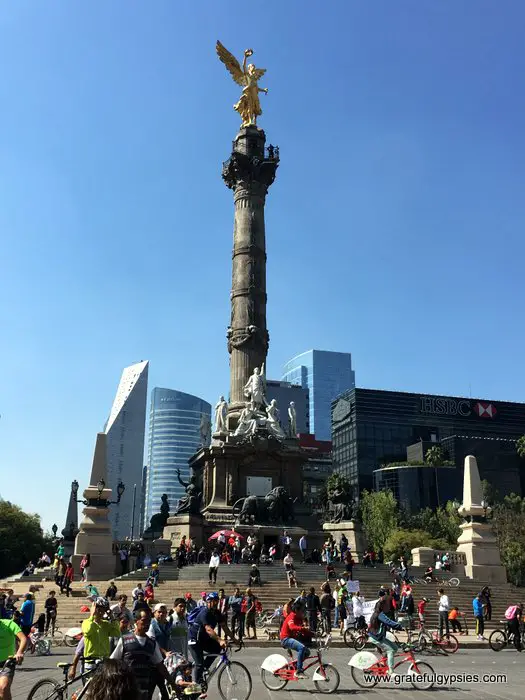

Conclusion
There you have it!
I hope this post helps you plan your trip to Mexico City.
Many of these activities can be combined together for a really cool day. It should be enough for about 3-4 days. Of course, there are many other awesome things to do in the city, but this should be enough to get you started.
Special thanks to Fred from www.bombingscience.com for the photos of street art. Head over to his website for more graffiti art photos, interviews with artists, and more.
Pin It!
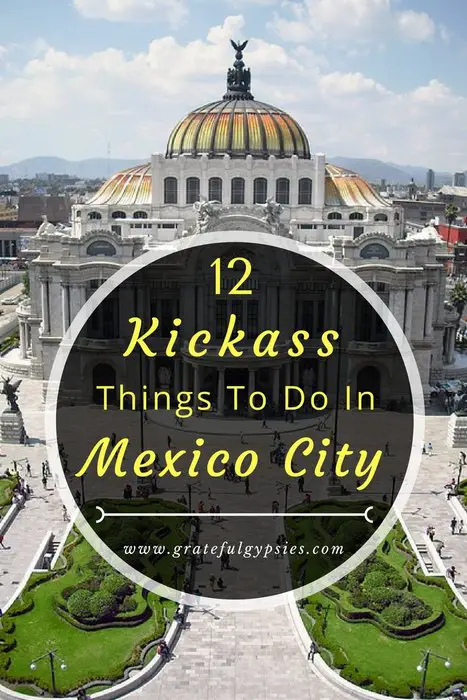




Thanks for sharing these information.
You’re welcome! Happy you found them useful 🙂
I definitely want to go to Mexico City and check out some of these places. Thanks for sharing.
Happy to hear that, Lucie! Thanks for reading! 🙂